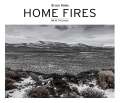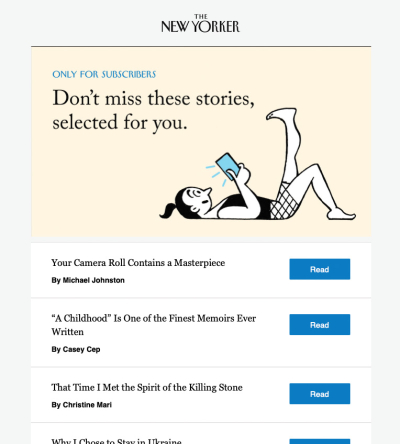Very wonderful red-letter day for me: my first-ever article for The New Yorker just went live at newyorker.com. It's called "Your Camera Roll Contains a Masterpiece." Comments/thoughts/ reactions welcomed.
Please tell your friends! Post on Facebook! Butters' friend Wex is here to play, so I'll have more to say later. (Guess that's always true.)
Mike
UPDATE: Check it out...it also made Apple News+ (you did know you can search Apple News+ for "photography," right? Okay, I didn't):
And Ken Tanaka noted that it made the evening's list of featured stories for subscribers:
Whew, what a day. One thing I also wanted to point out is that my editor there spent a very generous amount of his time with me, and the articles are carefully crafted with the help of various professionals in addition to his expert editing and direction. My piece ended up far stronger than it started out.
Book of Interest this Week
 Home Fires Volume II: The Present. There is of course a Volume I: The Past. TOP reader Bruce Haley has produced. This is his exploration of his home territories, and it's great.
Home Fires Volume II: The Present. There is of course a Volume I: The Past. TOP reader Bruce Haley has produced. This is his exploration of his home territories, and it's great.
This book link is a portal to Amazon.
Original contents copyright 2020 by Michael C. Johnston and/or the bylined author. All Rights Reserved. Links in this post may be to our affiliates; sales through affiliate links may benefit this site. As an Amazon Associate I earn from qualifying purchases.
(To see all the comments, click on the "Comments" link below.)
Featured Comments from:
Stelios: "I was thinking just that yesterday. What am I going to do with the thousands of pictures on my phone? What happens when the phone goes? Sure I download them on my computer but still, they are so many! Most of them notes. Thousands of my dog, most failures, or identical to each other (you can only have so many pictures of a dog lying upside down, all the same and yet all different because they happen now!). Congratulations on the New Yorker article. I hope there’s more coming."
Niels: "Great article, congratulations!
"I don't understand why they couldn't link to this blog in the credits, but they appear only to do internal links.
"English isn't my first language, but the article seems a bit more polished than I am used to from you—which is understandable given the medium, but I kind of prefer the style on this blog—it is more lively—in lack of better word.
"I hope you will also notify your readers when the next article is up."
Mike replies: Well, on them not linking here...it might be a little like when I hired one of the caregivers at my son's daycare center to come stay with him while I traveled to the yearly photo trade show at the Javits Center. The neighbors said she held parties at my condo every night and that they heard my three-year-old crying at midnight. She left some shot-glasses in the dishwasher, and one of my bedsheets was in the dumpster down in the garage with cigarette burns on it. When I asked the director of the daycare center about it, she said, "we can only guarantee their behavior while they're here." (The next year, I got my Mom to come stay with Xander.) I would guess that about sums up why The New Yorker doesn't link directly to things like triflin' lowdown no-editor-having blogs and the like—they can only guarantee my behavior when I'm there. (Where's that laughing emoji with the crying eyes when you need him?)
Animesh Ray: "Beautiful article. Thoughtful. Ruefully romantic. Sparkling with insights. Congratulations."
Antonis R: "Well, first: Congratulations Mike! To New Yorker's credit, they know to pick among the very best. I have been reading your wordsmithing since the days of the 37th Frame (I always opened the magazine from the back!) and this one, referencing 'Your Camera Roll' suggested a continuity in tone. Encouraging, evocative, informative, at once very personal and truly universal. It's in a different voice than, say, blog posts with their own casual charm. Making us create a mental image for a picture that only appears in words is brilliant, but how the subject switches from 'a woman in dark clothing' to 'we had gone to...' takes us across the chasm from generic to intimate and to the emotional essence of the story in a quick flash. Some sharp writing there.
"I know things live in the Cloud these days, but I wish a selection of your writing would come together, ink-on-paper, in a bound volume. A photography how-to manual with no technical instructions."
Mike replies: I tried once, but I'm too disorganized. Couldn't bring it together. I did hire a friend's daughter to clip all my magazine articles, rather than throw them away. Filled six (or was it eight? Where's the fact-checker?) three-ring binders! But they're here, at least.
Patrick Murphy: "OMG! Just saw your New Yorker article (via Apple News+, not from your blog). As you began to describe the 'woman by the sea' photo, a chill went up my spine. I purchased that photo during your print offer last year. It was the only print I’ve bought from you in the two decades of my reading your exceptional blog—the only print that really moved me. And now here it is shared with the world at large. The photo alone is an evocative masterpiece. Your description of its taking and meaning to you is what put it over the top for me. Congratulations to you on your as-always insightful writing getting the audience it deserves!"
Aaron: "After thinking more about your piece: given that we are awash in images and that our phones give us such easy access to making photographs I think you should write something on when not to take a picture. I hasten to say that this isn’t motivated by digital grouchiness or nostalgia for the good 'ol days. Rather, I’m interested in how not taking a photograph can be a way of practicing taking better photographs. I remember reading once that in a piece of music the negative spaces—the pauses, decrescendos, rests—were as or more important than the positive spaces—the notes, chords, accents, and so forth. Music is only music when the notes are framed by emptiness. A set of notes played continuously is noise not music. In our image saturated world—and our image saturated personal lives—perhaps there’s an analogy to be made. The images we do have are enhanced by the images we intentionally refrain from making. I also remember (though I can’t recall who) a professional nature photographer saying that he could only photograph a small percentage of the beautiful things he saw simply because the other things would not work as a photograph. Knowing when not to take a picture was part of his craft.
"Just this morning, clouds are clearing after several gray days and they have a the clarity and brilliance that seems only to come after rain—but these particular clouds in this particular setting won’t photograph well. Learning to appreciate the photos I do have may be part and parcel with remembering to appreciate the moments that can’t be photographs, and crucially appreciating them as moments, not as potential photographs. Again, I don’t mean this as general life advice (don’t let photography rob you of appreciation for what can’t be photographed). But, rather, I wonder if there’s something to learn about taking better photographs by paying attention to what can’t be photographed successfully."
Curt Gerston: "I’ve been a New Yorker subscriber since my dad got me my first subscription as a going-to-college gift in 1986. Great magazine…you absolutely belong. Congrats!"
Alvan: "Congratulations, Mike! A lovely, fluent, illuminating piece. You're an inspiration in many ways. Long may these—pictures, pieces, muses—continue! Long-time reader (and lurker) here, harking from Singapore."
Andre Y: "Congratulations Mike! To the story of NatGeo editors wanting a surfeit of photos to distill down to 15–20 perfect ones for the story, it's thought that in documentary filmmaking, an 80X ratio (that's eighty times) is about the right amount of footage for B-roll. That is, you need to shoot 80 times as much footage as you might use for the ancillary, illustrative stuff in your film."





Congratulations Mike for the thoughtful article and recognition!
Posted by: Ron Hoffer | Saturday, 02 April 2022 at 05:47 PM
Mike, your heartfelt article brought to mind the following excerpt from the poem 'Introduction to Poetry' by Billy Collins:
I ask them to take a poem
and hold it up to the light
like a color slide
or press an ear against its hive.
I say drop a mouse into a poem
and watch him probe his way out,
or walk inside the poem's room
and feel the walls for a light switch.
I want them to water ski
across the surface of a poem
waving at the author's name on the shore.
Posted by: Robert Stahl | Saturday, 02 April 2022 at 06:00 PM
Congratulations. A well written, insightful piece, iIn a publication worthy of your talents. I hope this is only the first!
Posted by: Frederick Mueller | Saturday, 02 April 2022 at 09:58 PM
Congratulations, Mike! Great article.
Posted by: Gary Nylander | Sunday, 03 April 2022 at 12:42 AM
Sorry Mike, I only just read your column. Outstanding! I hope you have many more.
Posted by: Bob Johnston | Sunday, 03 April 2022 at 06:56 AM
Congratulations! You've provided the photographic community with so many insightful comments dating back to the Sunday Morning Photographer, your "Ying & Yang" comments about gear in Photo Methods magazine, your 37th frame publication and now with T.O.P.
Your are my first read each and every morning before I move onto
the New York Times.
Wishing you good health and continued success.
Posted by: Mark | Sunday, 03 April 2022 at 09:39 AM
“instead of grieving, be grateful” That one idea was an absolute gem. Great article. A hearty congratulations to you Mike.
Posted by: Tom | Sunday, 03 April 2022 at 11:06 AM
Good work Mike!
Posted by: terence morrissey | Sunday, 03 April 2022 at 11:11 AM
Wonderful piece. You should be very proud. Well done.
Posted by: Mike Plews | Sunday, 03 April 2022 at 11:14 AM
Excellent! What will you write for them next?
Posted by: Sharon | Sunday, 03 April 2022 at 03:05 PM
Hi Mike: I've been digital-only for decades now. I've evolved a workflow that resembles the one you have described for the B&W days. At least in intent and outcome if not in detail.
I upload each new set of pix and do a quick triage. Some pix are family and friends, some are in support of my advocacy gang, and a few are more personal because of their content and meaning (these are the ones I love, and that keep me out there shooting).
Each selected photo gets a little tweaking -- crop, rotate, white balance, colour adjust. Some, but not much of any of these.
Then I put the personal pix in a folder which is displayed in rotation on my second screen by screen-saver software.
The second screen is pretty good, but not extraordinary. It is colour-balanced and big.
Over the course of time, as the screensaver rotates through the personal folder, I see each photo on screen for 15 minutes.
I soon find out which work and which don't. And over the course of weeks or months, I can learn and evolve my thoughts about the pix I'm taking.
So this is similar to your old methods, and serves a similar intent.
Posted by: Ken Ohrn | Sunday, 03 April 2022 at 05:39 PM
Congratulations on being published in The New Yorker. A good read. I read it in Apple News and immediately forwarded the link to a few friends.
Posted by: Ludwig Heinrich | Sunday, 03 April 2022 at 08:37 PM
Heartfelt congratulations! I wouldn't have doubted you had the chops. So wonderful though that you and The New Yorker found each other.
Posted by: Moose | Monday, 04 April 2022 at 12:02 AM
Actually, most of the existing photographs (at least non-staged ones) can be also considered a result of editing: the photographer is looking at all of images which appears or flows in front of his eyes, and select the ones that he feels may have visual, documentary, informative content or any other possible value.
Let us say that the journal image editors may be happy to deal with this carefully pre-selected, pre-processed stuff, rather than look at 360° panoramas from continuously recording styreet-view cameras.
Congratulations for the publication!
Posted by: giulio croce | Monday, 04 April 2022 at 01:44 PM
Mike
I bet there are some readers who would be very interested in the details of the fact checking process. How specific do they get? What were some things that were "fact checked" that you thought were obvious to everyone? What kind of "mistakes" were found. Why did you make errors - if you can call them that - was it just dates wrong or some such or was it more complex.
May I suggest that you write this all out now that details are fresh in your mind and then, perhaps, someday make a post about it?
[No doubt some might be interested, but they ask that freelancers not share details of the process. Besides, I'm just one very minor data point. --Mike]
Posted by: T. Edwards | Tuesday, 05 April 2022 at 11:51 AM
Congratulations, Mike! About time the New Yorker recognized the quality of your prose.
The experience of reading that article was like enjoying a small, wonderful, multi-course meal in a fine dining room after having spent lots of time hanging out in the chef's kitchen tasting stuff. My thanks and compliments to you and your editors.
I confess, though, that the confluence of two of the most rewarding reading experiences on the web, while thrilling, is also a bit disorienting, and might take me some time to wrap my head around. But Go, Mike!
Posted by: robert e | Tuesday, 05 April 2022 at 02:18 PM